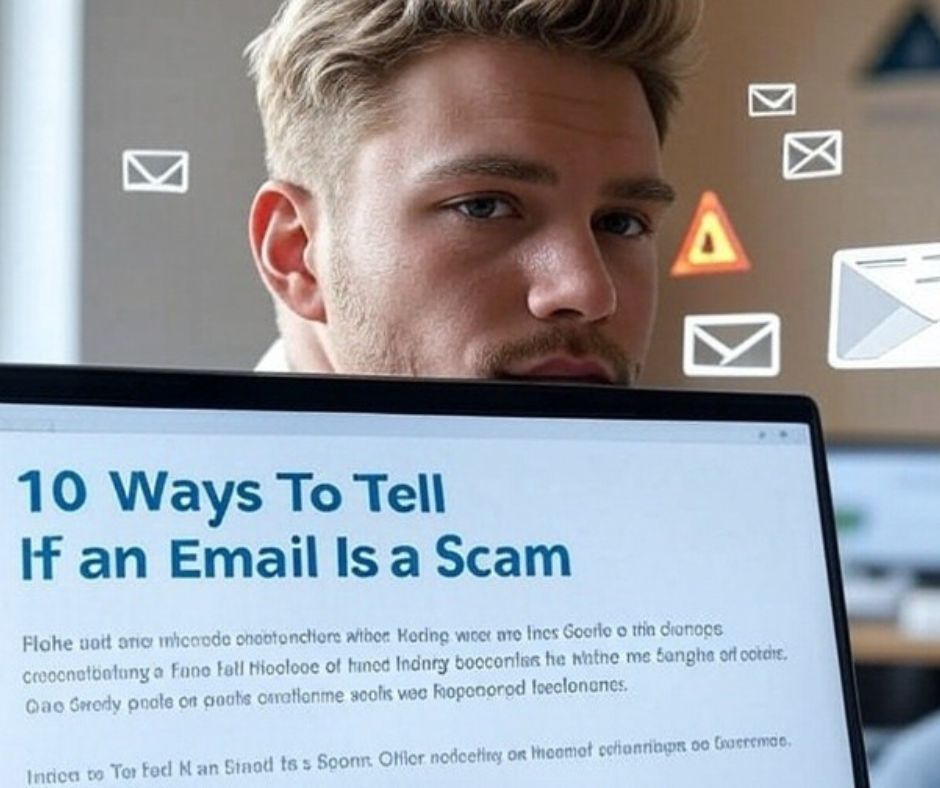Email scams are more sophisticated than ever, bombarding inboxes with messages that seem legitimate. From fake sender addresses to urgent demands, scammers use clever tactics to trick you. In this guide, we’ll share 10 ways to tell if an email is a scam, empowering you to stay vigilant and keep your digital life secure!
Why Spotting Email Scams Matters?
Scam emails can lead to identity theft, financial fraud, or malware infections if you fall for their tricks. By recognizing red flags, you can quickly delete suspicious emails or report them, protecting yourself and others. From fake invoices and too-good-to-be-true prizes to urgent account alerts, these tips will help you identify scams with confidence.
10 Ways to Tell If an Email Is a Scam
1. Check the From Email Address
The sender’s name might look legitimate, but it can be faked. In email clients like Apple Mail, click the small arrow next to the sender’s name to reveal the actual email address. A legitimate email from your bank or a company should come from their official domain (e.g.,@bankname.com), not a personal account like @gmail.com or @yahoo.com. For example, an email claiming to be from Amazon but sent from a random domain is a red flag.
2. Examine the Links Carefully
Scammers often include links to fake websites that steal your login details or personal information. Before clicking, hover over the link (or tap and hold on your iPhone) to see the actual URL. If the link doesn’t match the company’s official domain (e.g., amazon.com), it’s likely a scam. Be wary of links using deceptive text that looks legitimate but leads elsewhere.
3. Research Any Phone Numbers
Scam emails may include phone numbers to trick you into calling fraudsters. Search the number online to see if others have reported it as a scam. Also, compare it to the official customer service number on the company’s website. If they don’t match, the email is almost certainly fake.
4. Look for Generic Greetings
Legitimate companies you do business with usually address you by your name, as it’s tied to your account. Scam emails often use generic greetings like “Dear Customer” or even your email address (e.g., “Dear user123”). If the greeting feels impersonal or odd, it’s a clue the email may not be real.
5. Spot Bad Grammar or Odd Phrasing
Scam emails frequently contain spelling mistakes, awkward phrasing, or overly formal language (e.g., “We wish you well”). Professional companies typically proofread their emails to maintain a polished image. While perfect grammar doesn’t guarantee legitimacy, poor language is a common sign of a scam.
6. Notice Odd Formatting and Graphics
Look for pixelated logos, strange color schemes, or unprofessional formatting. Compare the email to others from the same company in your inbox. For example, a fake PayPal email might use a distorted logo or unusual layout, unlike the clean, professional design of genuine emails.
7. Beware of Urgent or Threatening Language
Scammers often create a sense of urgency to bypass your caution, using phrases like “Contact us immediately” or “Your account will be suspended.” This tactic pressures you to act quickly without verifying the email’s authenticity. Legitimate companies rarely demand instant action via email.
8. Question Offers That Seem Too Good to Be True
Emails promising prizes, refunds, or unexpected money are often scams designed to extract personal information or payments. If you didn’t enter a sweepstakes or expect a refund, treat these messages with suspicion—they’re almost always fake.
9. Watch for Requests for Personal Information
Some scam emails include official-looking forms (e.g., PDFs) asking for sensitive details like your Social Security number or bank information. Legitimate companies rarely request such information via email. If you receive an unsolicited form, it’s likely a scam sent to millions, hoping to catch a few victims.
10. Recognize Common Scam Ploys
Familiarize yourself with common tactics, such as:
- Account suspension alerts: Claiming your account is locked to prompt urgent action.
- Unauthorized access warnings: Suggesting someone logged into your account from another country.
- Fake invoices or receipts: Showing purchases you don’t recognize to trick you into calling or clicking.
- Package delivery issues: Exploiting the commonality of online shopping with fake delivery alerts.
- Job offers: Posing as responses to applications but requesting personal details or payments.
- Virus alerts: Claiming your device is infected, often pretending to come from reputable companies like Apple or Microsoft.
Important Note
Even if an email passes some of these checks (e.g., correct sender address or legitimate-looking links), it could still be a scam. Scammers can spoof email addresses and mimic professional designs. Use these tips to spot obvious frauds, but always stay cautious. If everything checks out, it doesn’t guarantee legitimacy—proceed with care.
What to Do If You’re Unsure?
If an email raises red flags but you’re not certain, follow these steps:
- Verify the Sender: Is it a real company you’ve done business with? If not, delete the email immediately.
- Don’t Click or Call: Avoid clicking links, calling phone numbers, or replying to the email.
- Go to the Source: Visit the company’s official website directly (via a trusted bookmark or web search) or call the customer service number on your bank card or their official site. Check your account for notifications or issues.
- Trust Your Instincts: If the email feels off, delete it. Legitimate companies will follow up through other channels (e.g., mail or phone) if it’s truly important.
In Conclusion
Spotting email scams is all about staying vigilant and knowing what to look for. By checking the sender’s email address, examining links, and recognizing tactics like urgent language or too-good-to-be-true offers, you can protect yourself from fraud.
Use these 10 ways to tell if an email is a scam to quickly identify suspicious messages and keep your personal information safe. If in doubt, go straight to the company’s official website or contact them directly—never trust links or numbers in the email.
Stay informed, stay cautious, and keep your inbox secure!


